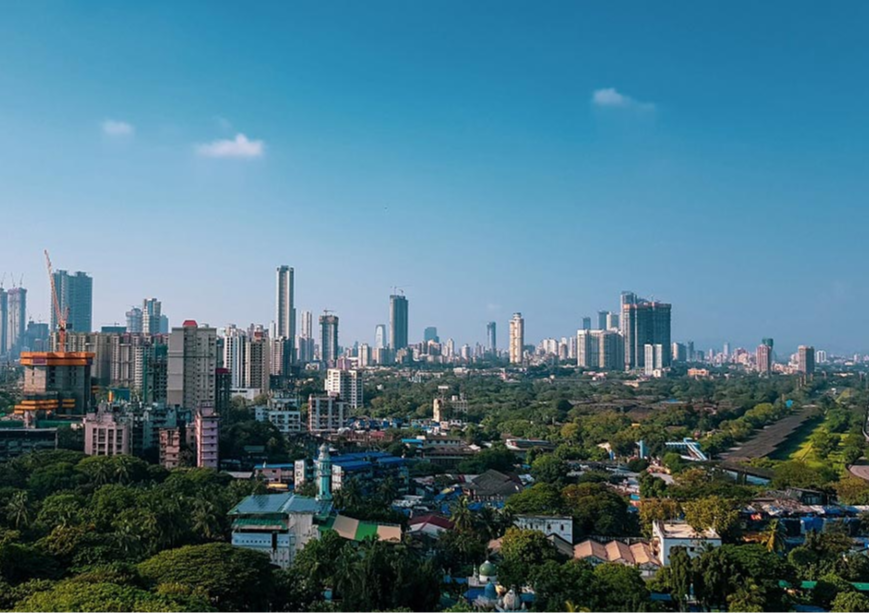
While the 2030 Agenda and the Paris Agreement are meant to address global common challenges, optimal solutions to these challenges require an understanding of their local nuances. Cities account for more than 70 percent of both global GDP and Greenhouse Gas (GHGs) emissions. A course correction in relation to the development model being pursued will inevitably have to articulate an action plan for sustainable urbanisation and sustainable cities. According to the United Nations estimates (2005), cities constitute 55 percent of the population and are expected to rise to 68 percent by 2050. Urban centres in India accounted for 37.7 crore people in 2011, and this figure is projected to reach 56 crores by 2031. It is only fitting then that the locus of implementation of both Sustainable Development Goals (SDGs) and climate action should be planned urbanisation and thriving cities. Urban resilience has many faces. It represents the calibre of an urban ecosystem and its constituents viz. individuals, communities, institutions, businesses and systems to withstand, survive, persist, thrive, recover, adapt, transition or transform as a response to acute shocks or chronic stresses inflicting them.
Climate change adaptation involves measures that help withstand, survive, persist, thrive, recover or adapt as a response to the current and future consequences of climate change.
Climate change is one of urban life's most urgent and biggest threats. Urban resilience to climate change involves mitigating risks induced by climate change or adaptation to such risks or both. Climate change adaptation involves measures that help withstand, survive, persist, thrive, recover or adapt as a response to the current and future consequences of climate change. Examples of climate change adaptation includes the construction of defences and the establishment of early warning systems for disaster risk reduction, institutional changes including new building codes, new insurance schemes, favourable regulations and policies, and the adoption of environmentally conscious lifestyles and livelihood strategies such as switching to plant-based diets. Climate change mitigation involves curbing or reducing further GHGs emissions which, in turn, reduce the intensity of the negative consequences entailing climate change. Climate change mitigation measures are underpinned by the ability to embrace the green transition and the associated structural transformation. These include installation and generation of renewable energy, adoption of clean transportation, deployment of green technologies, and greening of industrial processes and urbanisation.
The advent of the 4IR is being accompanied by threats to the employment prospects of unskilled/low-skilled workforce that is most likely to get replaced by technology. Urban resilience in this context refers to the ability to transition or transform by upskilling or reskilling for adapting to the skill set requirements of the labour markets. Such resilience is afforded by an educational and skilling system that is ‘malleable’ enough to provide the bandwidth for such upskilling and/ or reskilling.
The role of ULBs in enhancing urban resilience
The misalignment between the functions and finances of the Urban Local Bodies (ULBs) in India has been vitiating the institutional resilience of these governing bodies. The functional domain of ULBs is not defined clearly and overlaps significantly with that of the states. The ULBs rely heavily on their Own Source Revenue (OSR), which includes property taxes and user charges among other things. The lack of buoyant sources of revenue, and stringent control exercised by the state and the centre on the ability of municipal bodies to levy taxes, set rates, and access capital markets have debased their fiscal autonomy and, in turn, deflated their functional capacity.
The ULBs rely heavily on their Own Source Revenue (OSR), which includes property taxes and user charges among other things.
Unplanned urbanisation itself undermines urban resilience. The unplanned nature of urbanisation is mirrored in high levels of urban poverty and income inequality; excessive pressure on existing infrastructure; lack of access to basic amenities like health, education, housing, sanitation and clean drinking water; and a large informal economy characterised by meagre, irregular and uncertain wages, lack of social security and decent working conditions. The untoward consequences of unplanned urbanisation on resilience were demonstrated by the recent episode of the COVID-19 pandemic. It exposed the fragility of urban resilience in terms of social infrastructure and economic resilience by questioning its readiness to cope with unprecedented events.
There is a need to articulate an action plan that is based on a nuanced and comprehensive understanding of various risks confronting cities and their interconnectedness, and that which comprises attempts to strengthen urban resilience across all dimensions. A roadmap for urban resilience cannot be envisioned in isolation from a financing strategy that delineates how resources should be mobilised for and allocated to the implementation of such a roadmap. The first essential steps in this context involve defining clearly the functional space of ULBs and allowing them the requisite financial autonomy—both of which will enable them to devise strategies for improving urban governance. Municipal bodies will be able to map, in a clear-cut manner, each function to a corresponding fiscal source. The ensuing clarity will empower municipal bodies to devise and implement administrative and governance strategies, and urban plans and projects that are effective and efficient from the perspective of urban resilience. Financial autonomy is critical for municipal authorities to articulate fiscal solutions for boosting their OSR to finance urban resilience efforts.
Furthermore, the ULBs can formulate an action plan for accessing capital markets and developing well-functioning and matured municipal bond markets for mobilising resources for urban resilience. ULBs need to design robust accountability and financial management protocols. Municipal authorities can provide tax incentives that do not compromise the buoyancy of OSR. The Reserve Bank of India can consider allowing investments in municipal bonds to satisfy Statutory Liquidity Ratio (SLR) requirements. ULBs can undertake measures that enhance fiscal transparency (for example, a digital portal that provides up-to-date information that reflects the fiscal health of the concerned ULB) and build investor confidence. An agency dedicated exclusively to the provision of end-to-end technical assistance for municipal bond issuances can also be set up. Institutional investors can be mandated to invest a minimum percentage of their portfolios in municipal bonds.
ULBs need to design robust accountability and financial management protocols. Municipal authorities can provide tax incentives that do not compromise the buoyancy of OSR.
A careful scrutiny of urban resilience goals suggests that they eventually correspond to one or the other of the SDGs. In other words, financing SDGs translates into financing urban resilience. The Green, Social, Sustainability (GSS+) bonds can be leveraged to finance urban resilience. Nevertheless, if urban resilience goals are mapped into the existing SDG targets and indicator frameworks, one will realise while the SDG targets are compatible with a pre-emptive, proactive and predictive approach, the indicators are few and reactive in nature. Once this limitation of the SDG indicator framework is addressed, it can be the basis for monitoring and evaluation of the progress made in terms of urban resilience and of associated impact assessment.
Land-based finance (LBF) has attracted significant attention in the recent past as a fiscal solution for subnational governance. Given its adaptability to institutional and cultural contexts, lower adverse impact on private investments, and its accrual of social, economic and spatial benefits, LBF can be capitalised for attaining urban resilience goals. However, this will require strengthening the administrative and technical (valuation) capacities of ULBs as well as their coordination with other levels of government. It is critical to ensure that the application and utilisation of LBF do not violate the principles of distributive justice and equity.
The role of PPPs
Private sector participation can be leveraged in the form of blended finance that complements inadequate municipal resources with private sector investments and Public-Private Partnerships (PPPs), which augments capital, technical and operational efficiencies of projects catering to urban resilience by virtue of private intervention.
Financing adaptation projects is undermined by data and reporting challenges, information asymmetries, lack of a common measurement standard for assessing risks and benefits, complex financing mechanisms, and viability and bankability constraints.
A significant part of getting urban resilience right involves addressing the challenges associated with financing climate change adaptation. These challenges are reflected in the significant disparity in adaptation finance needs and the actual financial flows. Financing adaptation projects is undermined by data and reporting challenges, information asymmetries, lack of a common measurement standard for assessing risks and benefits, complex financing mechanisms, and viability and bankability constraints. There is a need to formulate a robust and well-defined methodology for tracking, monitoring and evaluating financial flows as well as their outcomes and impact. Streamlining documentation and making available necessary information about the project such as adaptation potential, objectives, and climate risks tackled can boost investor confidence. A repository of case studies on adaptation projects can aid in mobilising finance by providing a template for the successful implementation of projects. Building the capacity of ULBs to undertake risk assessments and scenario analysis and facilitating exchange between technical experts and policymakers can leverage financial flows more effectively for adaptation purposes. Adaptation projects take time to scale and become commercially viable. Innovative solutions that have financing structures and risk mitigation features that seek to address the above-mentioned challenges can be designed.
According to a World Bank study, urban India is likely to incur significant costs—somewhere between US$ 2.6 billion and US$ 13 billion annually, and 1.2 percent to 6.3 percent of the GDP by 2050—in the absence of proper planning and management of urbanisation and cities. Therefore, India has to acknowledge the urgency of mainstreaming concerns of resilience in the broader vision for sustainable urban development, articulate appropriate interventions that address these concerns and mobilise the requisite financial resources to do so.
Renita D’Souza was a Fellow at the Observer Research Foundation
The views expressed above belong to the author(s). ORF research and analyses now available on Telegram! Click here to access our curated content — blogs, longforms and interviews.




 PREV
PREV

.png)
.png)